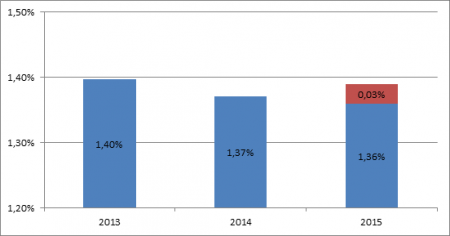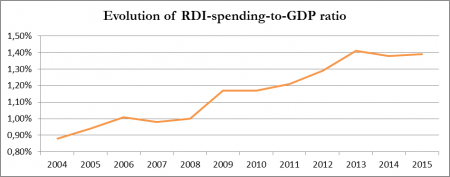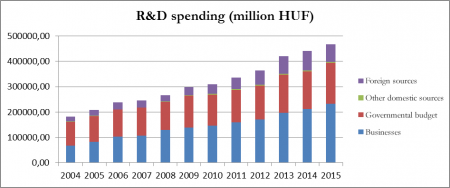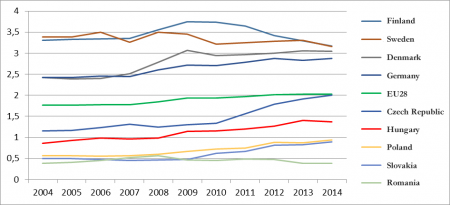The RDI-spending-to-GDP ratio has slightly increased since the previous year to 1.39%. Businesses RDI spending has shown steady increase for years, and since 2014 the government has also allocated more for RDI purposes.
Public spending on RDI dropped in 2014 but increased again in 2015. More than HUF 50.5 billion (over EUR 160 million) was disbursed from the National Research, Development and Innovation Fund in 2015.
Businesses played a major role in the growth of RDI spending. The sudden rise in the RDI-spending-to-GDP ratio between 2012–2013 (this rate was 1.29% in 2012) marked the beginning of a sustainable and well-established RDI activity, which can be further intensified to achieve the expected ratio of 1.8% by year 2020.
Without the extra payments from the NRDI Fund, the RDI-spending-to-GDP ratio would not have increased either.
The increasing investments of businesses in RDI (around HUF 230 billion i.e EUR 730 million in 2015) is the sign of a stronger business sector. It also shows that – similarly to leading countries where RDI spending is dominated by the private rather than the public sector – Hungary also witnessed a positive change in this field (e.g. compared to 2015 where public sources exceeded private sources). By developing and operating a predictable competitive bidding system that encourages the RDI activity of businesses, the Hungarian RDI policy greatly contributed to the long-term sustainability of this trend. To this end, the NRDI Office proposed to create elements in the competitive bidding portfolio that incentivise businesses to engage in research and development. Accordingly, calls for applications to non-refundable support are expected to be announced in 2016 with a framework budget of around HUF 200 billion (EUR 635 million), financed from the NRDI Fund and the EU operational programmes.
The decrease in foreign sources (including among others the sources of the Horizon 2020 Framework Programme, while the EDIOP and CCHOP calls financed from the EU Structural Funds appear in the “State budget” column) is relative: after the 2014 peak the share of such sources returned to a level slightly exceeding the 2013 level. The NRDI Office stimulates the competitiveness of domestic RDI actors with various instruments. Such instruments include calls financed from domestic sources encouraging international networking and consortium building, and calls providing funds to internationally competitive projects, which were not supported from foreign funds, until the submission of the next international application. The competitive bidding portfolio financed from the NRDI Fund and the EU Structural Funds has been designed to strengthen the international relations, competitiveness and research infrastructure of domestic RDI actors, so that they can participate more successfully in international calls for applications.
In addition, the NRDI Office also attempts to enhance the success rate of the Hungarian applications by operating a network of national contact points (NCP). In addition to participating in the preparation of H2020 calls, the experts of the NRDI Office also represent the interests of the Hungarian researcher community as regards the form of utilisation of H2020 funds. Thus, for instance, in the field of financing researchers' salaries under the H2020 programme which is a major challenge for Hungarian institutions, since regulations regarding the means used to top up salaries became more stringent than in the previous framework programmes. The NRDI Office has cooperated with the Hungarian researcher community to develop the arguments and proposed solutions which form the basis of future consultations with the European Commission.
Unfortunately, the number of RDI centres and professionals working in the RDI field decreased in 2015. The rate of the latter (1.6%), however, is not as high as the decrease in the number of RDI centres (6.8%). The instruments available for the NRDI Office alone are insufficient to reverse this trend, so the President of the Office has already raised in several forums that new solutions are required. Nevertheless, the NRDI Office tries to buck the trend by introducing incentives for RDI financing. As the increased funds can only be utilised in a value-creating way by excellent researchers, the competitive bidding system applies research funding and other RDI policy instruments to make the researcher career more attractive, such as by launching programmes which provide funds for various researcher career stages. Such programmes include the revamped Researchers' Thematic Applications Programme and the Call for Postdoctoral Applications. The legislative changes published on 15 June 2016, initiated by the NRDI Office, foster the more efficient utilisation of funds by providing tax exemption to fellowship grants financed from the NRDI Fund, including the already announced call for applications for postdoctoral fellowship.










